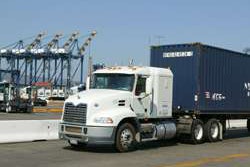The University of Manitoba Transport Institute and TransCore Link Logistics on Monday, Nov. 22, announce the initial results from their joint research project looking at Canadian trucking and logistics trends using TransCore’s Loadlink freight matching data. This will be the first installment in a four-part educational series.
Paul Larson, director of the Transport Institute at the University of Manitoba, says using TransCore’s data “provides us a particularly compelling view into the Canadian logistics market. Observations that in the past might have been more intuitive in nature are now backed with qualitative and quantitative assessment, both confirming and expanding our understanding of the dynamics at play in the Canadian market.
Larson says the data also supports UMTI’s commitment to the Innovative Freight Practices project to reduce empty backhaul miles and GHGs. “Freight matching can enhance service, reduce costs and make freight movement more sustainable in the long run,” he says.
Highlights from initial findings include:
• Postings originating in the United States bound for Canada amounts to more than 61 percent of total freight volume and 39 percent of equipment volume;
• Outbound postings from Canada to the United States accounts for 13 percent of load volumes and 31 percent of equipment volumes;
• Domestic freight within Canada is 21.8 percent and equipment is 30 percent;
• The top sources of freight by province or state are, in descending order, Ontario, Quebec, Ohio, Pennsylvania, Illinois, California, Alberta, British Columbia, Texas, Indiana, Missouri and New York;
• The top 12 freight destinations by province or state are, in descending order, Ontario, Quebec, Alberta, British Columbia, Manitoba, Saskatchewan, New Brunswick, New York, Nova Scotia, Texas, Pennsylvania and California;
• The top five source cities for freight are the Greater Toronto Area, Montreal, Calgary, Edmonton and Chicago;
• The top five destination cities for freight are the Greater Toronto Area, Montreal, Calgary, Edmonton and Winnipeg;
• Year-over-year load postings have recovered dramatically from the lower than average values of the summer of 2009. Year-to-year postings have increased from 30 percent to 52 percent;
• Year-over-year equipment postings have decreased between 12 and 18 percent;
• Year-over-year recovery in the loads from July-Sept/09 to July-Sept/10 was greater in the transborder market. The reduction in capacity may be hitting the Canadian domestic market harder than the transborder market. One possible explanation is that since the transborder load market recovery has been proportionally greater than that of the Canadian domestic market, trucks have been diverted to the transborder market at the expense of the Canadian market;
• Year-over-year load postings in the domestic Canadian market increased between 30 and 48 percent, whereas domestic equipment postings decreased between 10 and 36 percent; and
• Year-over-year load postings in the transborder market increased between 29 and 55 percent, whereas equipment postings only decreased by 12 to 20 percent.
“By identifying patterns of freight movement within Canada and across the U.S. border, Canadian transportation companies can make valuable insights to improve their operating efficiencies,” says Claudia Milicevic, TransCore’s Link Logistics general manager. “It can also assist carriers with better load planning by optimizing their trip scheduling and reducing empty miles.”













